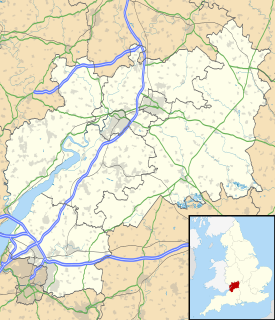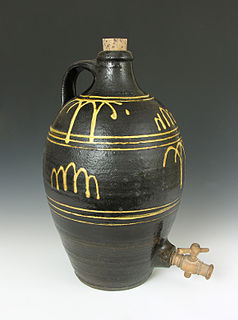
Pottery is the process of forming vessels and other objects with clay and other ceramic materials, which are fired to give them a hard, durable form. Major types include earthenware, stoneware and porcelain. The place where such wares are made by a potter is also called a pottery. The definition of pottery used by the American Society for Testing and Materials (ASTM), is "all fired ceramic wares that contain clay when formed, except technical, structural, and refractory products." In archaeology, especially of ancient and prehistoric periods, "pottery" often means vessels only, and figures etc. of the same material are called "terracottas". Clay as a part of the materials used is required by some definitions of pottery, but this is dubious.

Raku ware is a type of Japanese pottery traditionally used in Japanese tea ceremonies, most often in the form of chawan tea bowls. It is traditionally characterised by being hand-shaped rather than thrown, fairly porous vessels, which result from low firing temperatures, lead glazes and the removal of pieces from the kiln while still glowing hot. In the traditional Japanese process, the fired raku piece is removed from the hot kiln and is allowed to cool in the open air. The familiar technique of placing the ware in a container filled with combustible material is not a traditional Raku practice.

Pottery and porcelain, is one of the oldest Japanese crafts and art forms, dating back to the Neolithic period. Kilns have produced earthenware, pottery, stoneware, glazed pottery, glazed stoneware, porcelain, and blue-and-white ware. Japan has an exceptionally long and successful history of ceramic production. Earthenwares were created as early as the Jōmon period, giving Japan one of the oldest ceramic traditions in the world. Japan is further distinguished by the unusual esteem that ceramics holds within its artistic tradition, owing to the enduring popularity of the tea ceremony.
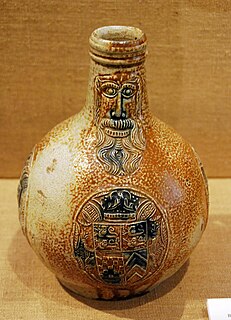
Salt-glaze or salt glaze pottery is pottery, usually stoneware, with a glaze of glossy, translucent and slightly orange-peel-like texture which was formed by throwing common salt into the kiln during the higher temperature part of the firing process. Sodium from the salt reacts with silica in the clay body to form a glassy coating of sodium silicate. The glaze may be colourless or may be coloured various shades of brown, blue, or purple.
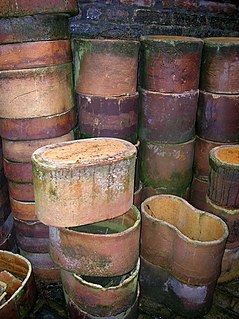
A saggar is a type of kiln furniture. It is a ceramic boxlike container used in the firing of pottery to enclose or protect ware being fired inside a kiln. Traditionally, saggars were made primarily from fireclay. Saggars have been used to protect, or safeguard, ware from open flame, smoke, gases and kiln debris: the name may be a contraction of the word safeguard. Their use is widespread, including in China, Korea, Japan and the United Kingdom. Saggars are still used in the production of ceramics to shield ware from the direct contact of flames and from damage by kiln debris. Modern saggars are made of alumina ceramic, cordierite ceramic, mullite ceramic silicon carbide and in special cases from zirconia.

Slipware is pottery identified by its primary decorating process where slip is placed onto the leather-hard clay body surface before firing by dipping, painting or splashing. Slip is an aqueous suspension of a clay body, which is a mixture of clays and other minerals such as quartz, feldspar and mica. The slip placed onto a wet or leather-hard clay body surface by a variety of techniques including dipping, painting, piping or splashing.
Langley Mill Pottery was located in Langley Mill, Derbyshire on the Derbyshire – Nottinghamshire border. From its establishment in 1865 to its final closure in 1982, the pottery went through five distinct periods of ownership, producing a wide range of stoneware ranging from salt glazed ink bottles, utilitarian items and tableware to high quality and original art pottery.

Chinese ceramics show a continuous development since pre-dynastic times and are one of the most significant forms of Chinese art and ceramics globally. The first pottery was made during the Palaeolithic era. Chinese ceramics range from construction materials such as bricks and tiles, to hand-built pottery vessels fired in bonfires or kilns, to the sophisticated Chinese porcelain wares made for the imperial court and for export. Porcelain was a Chinese invention and is so identified with China that it is still called "china" in everyday English usage.
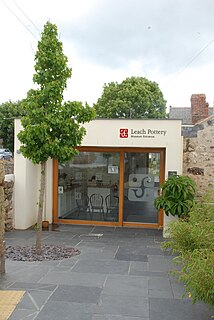
The Leach Pottery was founded in 1920 by Bernard Leach and Shoji Hamada in St Ives, Cornwall, in the United Kingdom.
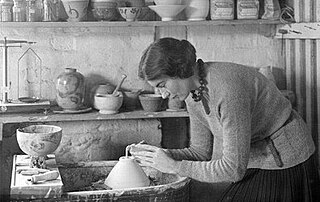
Ursula Frances Elinor Mommens was an English potter. Mommens studied at the Royal College of Art, under William Staite Murray, and later worked with Michael Cardew at Winchcombe Pottery and Wenford Bridge Pottery.

KatherineHarriot Duncombe Pleydell-Bouverie was a pioneer in modern English Studio pottery.

Gwyn Hanssen Pigott OAM (1935–2013) was an Australian ceramic artist. She was recognized as one of Australia’s most significant contemporary artists. By the time she died she was regarded as "one of the world's greatest contemporary potters". She worked in Australia, England, Europe, the USA, New Zealand, Japan and Korea. In a career spanning nearly 60 years, influences from her apprenticeships to English potters were still apparent in her later work. But in the 1980s she turned away from production pottery to making porcelain still-life groups largely influenced by the Italian painter Giorgio Morandi.
Reg Preston studied sculpture at the Westminster School of Art in London, in 1938. At the beginning of WW2, he returned to Australia and spent three months in 1944 potting at the Melbourne Technical College with John A. Barnard Knight and Klytie Pate. Throughout 1945-1946, he worked at Cooper and Cooke's Pottery.
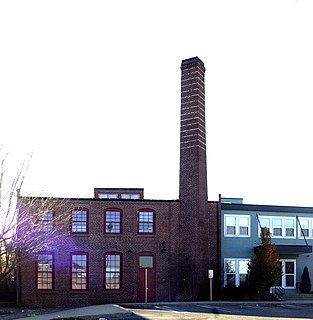
Dorchester Pottery Works is a historic site at 101-105 Victory Road in Dorchester, Massachusetts, a neighborhood of Boston. The Dorchester Pottery Works was founded in 1895 by George Henderson and made stoneware. The Dorchester Pottery Works closed in 1979. The building was designated as a Boston Landmark in 1983 and added to the National Register of Historic Places in 1985.
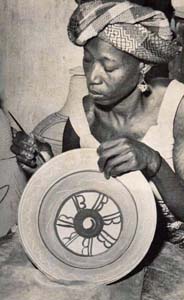
Ladi Kwali, OON, MBE was a Nigerian potter.
Eric Norstad was an American potter and architect who worked primarily on the west coast of the United States.

Ray Finch MBE, formally Alfred Raymond Finch, was a respected English studio potter. who worked at Winchcombe Pottery for a period spanning seventy five years.

The Coxwold Pottery was a pottery studio based in the village of Coxwold, North Yorkshire, launched by artist potters Peter and Jill Dick in 1965, and in operation until 2012.

Denise Wren, nee Tuckfield (1891–1979) was one of the first female studio potters in Britain. She set up the Oxshott Pottery in the village of Oxshott, Surrey, in 1920. Wren was born in Lake View, Albany, Western Australia on 7 January, 1891. Her family moved to East Molesey, Surrey, England in 1900.

